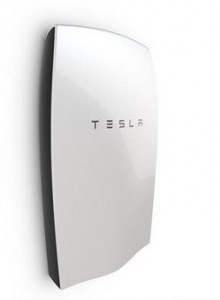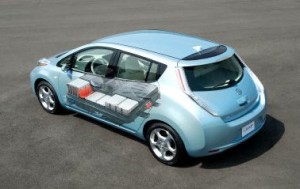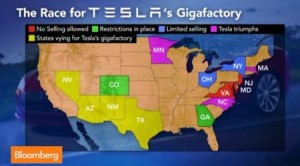 With its new energy storage division (called Tesla Energy), Tesla Motors continues to build on a strategy that’s working for other Silicon Valley neighbors such as Google and Apple. That would be: move into the next logical technology marketplace. Advanced batteries may produce more revenue and profit than electric cars for Tesla in the next few years – and they’ll contribute to Tesla CEO Elon Musk’s vision of reducing dependence on fossil fuels and supporting growth in renewable energy.
With its new energy storage division (called Tesla Energy), Tesla Motors continues to build on a strategy that’s working for other Silicon Valley neighbors such as Google and Apple. That would be: move into the next logical technology marketplace. Advanced batteries may produce more revenue and profit than electric cars for Tesla in the next few years – and they’ll contribute to Tesla CEO Elon Musk’s vision of reducing dependence on fossil fuels and supporting growth in renewable energy.
Along with its electric drive system, Tesla’s greatest strength is batteries – making its $5 billion investment in the Gigafactory potentially more than worthwhile; the company expects the Nevada factory to reach full capacity by 2020 and make more lithium-ion batteries than were produced worldwide in 2013. Tesla Energy will be ready to bring Tesla batteries to homes, business, and utilities to store energy to better manage power demand, provide backup power, and increase grid resilience – with much of it coming from solar power.
Called the Tesla Powerwall, it includes Tesla’s lithium-ion battery pack, liquid thermal control system, and software that receives dispatch commands from a solar inverter. Tesla Powerwall will be built into a building’s wall and will be integrated with the local power grid so that customers can draw energy from their own reserve. Benefits will include cost savings through load shifting during low rate periods; storing surplus solar energy; increasing the capacity for using more solar; and providing backup energy during grid outages.
It’s available in 10kWh, optimized for backup applications, or 7kWh, optimized for daily use applications. Tesla’s selling price to installers is $3,500 for 10kWh and $3,000 for 7kWh. Those prices exclude inverters and installation costs. The company says that deliveries will begin in the late summer of 2015.
Tesla has been testing out energy storage projects with some big-name partners including Amazon and Target. Amazon’s cloud computing division, Amazon Web Services (AWS), has been working closely with Tesla for the past year on high-capacity battery technology in data center applications. Target has partnered with Tesla on a pilot test at select Target stores to incorporate Tesla Energy Storage as part of its energy strategy. Tesla has also been supplying batteries to Walmart through pilot projects and a supply agreement with SolarCity Corp. Jackson Family Wines is using Tesla’s stationary energy storage solution in four areas that account for the most consumption in its winemaking process: refrigeration/cooling, lighting, compressed air, and process water treatment.
Utilities and solar companies are also working with Tesla on energy storage systems for meeting the next wave of energy demands. Southern California Edison has developed the nation’s largest battery storage system and has contracts in place for an additional 264 megawatts of storage, including projects using Tesla batteries.
Tesla has “channel partners” in place for producing the Powerwall. TreeHouse, a sustainable home improvement store, is working with Tesla to sell the Powerwall home battery. SolarEdge, a leader in the global photovoltaic (PV) inverter market, has a deal with Tesla for joint development of a PV storage and backup power solution for the worldwide residential solar market. Vermont-based renewable energy company Green Mountain Power and Tesla will offer Vermont residents a way to use less energy and rely on the grid as a backup system.
Tesla CEO Elon Musk does have a few things in common with executives at neighboring Silicon Valley giants – with one of them being expanding into the next logical technology marketplace. He serves as chairman of SolarCity, the largest solar power company in the US (and one started up by Musk’s cousins); he leads innovative space travel company, SpaceX (and its Hyperloop high-speed rail project); the Gigafactory, which is still being developed in Nevada; and the Tesla Motors electric carmaking company, which holds the unique position of breaking into the tough auto manufacturing sector – and surviving.
The big question will be whether all of it will work. The massive investment in Tesla since startup has come from private equity shareholders, the stock market, corporate partners (such as Panasonic on the battery side and Daimler on the car manufacturing side), a US Department of Energy loan, and personal investments from Musk from his PayPal startup profits and from other Tesla executives. Tesla Energy will require significant investments in the next few years.
Competition in the energy storage market will be fierce. Coda Automotive may not be around anymore in the electric vehicle space, but Coda Energy does have several clients at commercial and industrial sites. Schneider Electric is known for its electric vehicle charging systems, but has a significant presence in the energy storage market. Major solar companies are entering the storage market, along with commercial building suppliers and large battery manufacturers. It may come together for Tesla, and it’s possible that advanced batteries and energy storage could make for the lion’s share of its revenue in the next 10 years.


